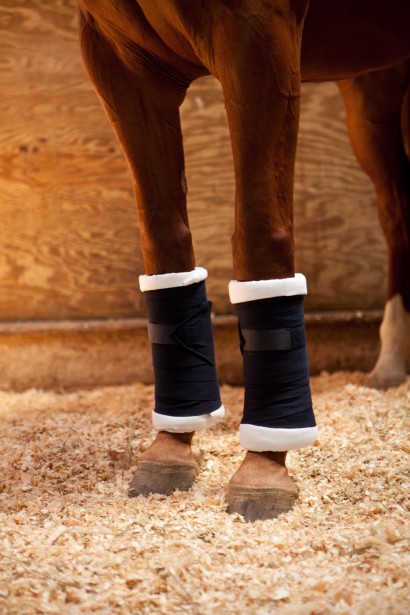Rehabilitation and Healing Time for Bowed Tendons and Pulled Suspensory Ligaments in Horses
By: Dr. Lydia Gray | Updated March 23, 2025 by SmartPak Equine
"My 15 yr. old mare has been diagnosed with tendinitis. She has been lame about 2 yrs. I have had her x-rayed, the vet says there are no signs of arthritis. She gets better then she gets worse. I have tried some lite riding. I have put her on SmartFlex Repair. She has been on this product 2 months. She is better now but not well. I have decided not to ride her anymore until she is well. How long should I keep her on this supplement before I can see some results, or will this supplement help a tendon problem? Thank You,"
- BC, North Carolina

Dear BC,
Having just rehabbed one of my horses through a “pulled” suspensory, I can sympathize with you and your horse’s “bowed” tendon. These two soft tissue problems are very similar, so I’ll provide some general information on both of them along with some specific recommendations for your horse’s particular problem.
First, let’s make sure we’re on the same page regarding the anatomy. A “bowed” tendon is named for the bow shape the back side of the lower limb (usually the front) develops because of swelling in the tendon. There are two tendons that run down the back of the leg. The one nearer the skin and the one that usually “bows” is the superficial digital flexor tendon. The one nearer the cannon bone is the deep digital flexor tendon.
The suspensory ligament runs from the knee (or hock) to the ankle, and lies between the deep digital flexor tendon and the cannon bone. It provides support to the ankle during the weight-bearing phase of the stride.
Tendinitis, or, inflammation of the tendon, usually occurs at high speeds or when horses are fatigued. Less-than-ideal training, conditioning, conformation, trimming, shoeing and footing are other factors that can lead to a strained or “bowed” tendon.
The causes of desmitis, or, inflammation of a ligament, are similar, and can lead to a sprained or “pulled” suspensory. Hint: to remember that tendons are strained and ligaments are sprained, think of straining your muscle (tendons connect bone to muscle) and spraining your ankle (ligaments connect bone to bone).
When a tendon first “bows,” horses are usually lame with pain, heat and swelling in the affected area. Unfortunately, horses with “pulled” suspensories don’t always show these obvious signs of injury. They may simply not feel right under saddle.
While x-rays are great to visualize bony structures, ultrasound is the imaging tool of choice when it comes to a soft tissue injury like a “bowed” tendon or “pulled” suspensory. Ultrasonography can provide measurements of just how severe the injury is. Follow-up images are useful in determining how healing is progressing and when a horse can be put back into work.
For example, this spring we used ultrasound to initially diagnose my horse with a “pulled” suspensory, then we imaged the leg every 30 days during his rehab to make sure the tears were filling in well. This helped me know when to safely start adding trotting, cantering, circles/corners and lateral work to his regimen.
Early treatment of a “bowed” tendon or “pulled” suspensory may include rest, cold therapy, pressure bandaging and anti-inflammatories. Therapies include IRAP (interleukin-1 receptor antagonist protein), stem cells and ESWT (extra corporeal shock wave therapy).

Oral silica and hydrolyzed collagen (gelatin) also have evidence supporting their use in the development of healthy connective tissue such as tendons and ligaments.
Here’s why no horse owner wants to hear that their horse has a “bowed” tendon or “pulled” suspensory: depending on the severity of the injury, a tendon may require six months or more to heal while a ligament may require nine to twelve months or more to heal. With either type of injury, the horse may not return to its previous level of performance.
My advice is to have a knowledgeable veterinarian sonogram your mare’s leg to determine the extent of the injury and its current status. Then, work with that vet to design a rehabilitation program—that may include a supplement to support joint and cartilage health—to try and return your mare to soundness.
Be aware that you may have to do more than simply stop riding her. You may also have to restrict her turnout so that she doesn’t move too much on her own and reinjure herself. I wish you the best of luck!